Lupine Publishers- Environmental and Soil Science Journal
Abstract
Reported Impact Assessment of an intervention ‘Land Shaping
Technology’ implemented at farmer’s field under NAIP project
at different villages of south 24-Pargans district of West Bengal aiming
for rainwater harvesting for irrigating crops. Farm data
was collected from the randomly selected farmers of both Interevent and
control groups. Partial budgeting analysis was done to
assess the comparative performances with respect to sources of income
and livelihoods, diversification of input cost, labour cost,
employment generation, production etc. The impact of Land Shaping
technology can be assessed from the fact that the landscape and
cropping pattern has been changed from single crop to multi crop round
the year resulting in enhanced productivity, employment
generation, income and related activities arresting migration of people
to cities in search of jobs for livelihood in intervened farmer’s
plots compared to those in control plots. Livelihood opportunities have
increased considerably in the area without affecting the
environment. Beneficiaries and family members are observed fully engaged
in farming, marketing and associated activities. Many
people have been affected directly and indirectly in agriculture related
activities like farming, input supply, trading, marketing
and transport operations as a result of intervention of the proven
technology of ICAR-CSSRI adopted by NAIP for field extension.
The Land Shaping Technology having potential of manifold increase
productivity in the low-lying saline belt of Sundarbans which
otherwise depends on seasonal rain, may be continued to a wider section
of non-beneficiaries for long term social, economic,
benefit and social equity resulting in a balanced society framework.
Introduction
India is one of the fastest growing economies in the world,
ranked among the top ten highest GDP countries, and is the world’s
second most populous country. During the past two decades, India’s
GDP grew at an average of 7 percent annually. In spite of impressive
economic growth and poverty alleviation, India is now at a critical
juncture in its paths towards becoming an economic powerhouse
and is facing important development challenges and structural
constraints to a more inclusive growth and a more sustainable
development. India remains home to 263 million poor people
most of which reside in rural areas. The economic growth has not
generated jobs fast enough to absorb labour out of agriculture
and low productivity rural jobs. To address these challenges,
the Government of India (GOI) has in recent years focused on
accelerating economic growth and poverty reduction, creating jobs,
improving environmental management and achieving an annual
growth in the agriculture and allied rural sectors of 4 percent in
its Union Budget, 2017-18, GOI articulated its resolve to double
farmers’ income in 5 years. It is widely accepted that Agriculture
sector’s growth is essential in achieving India’s development goals.
The sector currently accounts for 14 percent of national GDP and is a
source of livelihood for more than half of the population. More than
two thirds of the country’s poor live in rural areas, and their chance
of getting out of poverty directly depends on the performance of
agriculture and allied rural sectors. The agriculture sector also has
a major potential for creating rural employment and alleviation
of poverty. Against this backdrop, Government of India initiated
through a Mega project entitled ‘National Agricultural Innovation
Project (NAIP)’, funded by World Bank was in operation throughout the whole country and implemented through State Agricultural
Universities, ICAR Institutes and NGO organization that operated
in farmer’s field with proven technologies from various fields of
Agriculture, Animal Science, Forestry, Fisheries etc.
Under the subproject ‘Strategies for Sustainable Management of
Degraded Coastal land and Water for Enhancing Livelihood Security
of the Farming Communities’ an intervention named ‘Land Shaping’
for improving rainwater harvesting and drainage for enhancing
productivity at low lying degraded land including Tsunami affected
land at the District South 24 Parganas in the state of West Bengal’
was extended to farmer’s field termed as Intervention (treated).
The main objectives of Intervention were
i) Sustainable enhancement of the productivity of degraded
land and water resources of the coastal region through
integrated approaches.
ii) Enhancement of livelihood security and employment
generation for the poor farming communities of the coastal
region.
iii) Empowerment through capacity building and skill
development of stakeholders including men and women
farmers.
Type of Assistances Provided to Farmers
Farmers plots/farm was constructed by NAIP; Formation of
sustainable fund; Information regarding better input availability &
supply like Paddy (Aman, Mona, Gitanjali, Chaitali), Paddy seed &
Vegetable seed (Tejeswari, Avinash3, VNR28, 1458, 6214 etc.). After
completion of implementation of the project, NAIP intended to
assess the impact of the sub-projects based on the basic parameters
of effectiveness, efficiency, results/impact and sustainability. More
precisely, NAIP wants to undertake Outcome Focused Impact
Evaluation of sub-projects with the aim of Identification and
quantification of the field level impacts of the project interventions
in terms productivity, profitability, sustainability, employment,
equity, gender, input saving, cropping intensity, etc.
One of the Technology Intervention named ‘Land Shaping
Technology’ was taken up as an intervention for improving
rainwater harvesting and drainage for enhancing productivity
in the Sundarbans region was assigned to me for carrying out
Impact Assessment Study. Earlier reports on impact assessment
study on various interventions are reported worldwide covering
methodology as well as field implementations from FAO, UNDP,
UN, World Bank, ADB, NAIP and different researchers on various
crops technologies, intervention and scenario [1-31]. As it is known
that Partial budget analysis is a simple but effective technique
for assessing the profitability of new technology for an existing
enterprise. It also provides the foundation for comparing the
relative profitability of alternative treatments, evaluating their
riskiness, and testing how robust profits are in the event of changing
product or input prices. The method developed by International
Wheat and Maize Improvement Centre (CIMMYT), is extensively
used for estimating the financial impact of implementing a new
technology, in dairy research and plant protection research and
on various crops. Reports on Partial Budgeting, economic analysis,
Partial Budget to Analyse Farm Change, to estimate the cost and
benefit of adaptation of a new technology, Partial budgeting
technique, assessment of New technology that can be evaluated in
terms of its impact on the productivity, profitability, acceptability
and sustainability of farming systems are available [32-41].The
present study is attempted to evaluate the impact assessment of
intervention of ‘Land Shaping Technology, developed by ICAR-CSSRI
and extended under NAIP project on farmer’s field utilizing the
Partial budgeting technique in terms of productivity, profitability,
acceptability and sustainability of farming systems.
Methodology for the Present Impact Assessment Household Survey
i) Experimental Design: In the present impact assessment
study Ex Post design was adopted with provision for comparison
between Intervened and control group of households. Both
qualitative and quantitative data through random sampling and
purposive selection method is taken for collection of Primary
data for both treated and control groups of household farmers
respectively.
ii) Survey Instrument /Assessment Tools for Household
Survey: After thorough discussion the survey instrument
designed by NAIP was taken up for field data collection.
The questionnaire was designed mainly for financial impact
assessment was administered for primary data collection from
the field.
iii) Sample Size Selection: As per PIU, NAIP guideline that
at least 30 random samples of beneficiary farmers and 20
samples of control group farmers to be covered for primary
HH data collection for the intervention, from the frame of
beneficiary farmer’s household. In case of non-beneficiary
farmers (control) purposive sample method is resorted to from
the neighbouring areas where intervention was made.
iv) Sources of Data Collection: Primary and secondary
sources: Household survey, Market visits, Field Observations,
Key informants Interview and Transect walk besides Existing
literature of best practice of IA survey/study, NAIP Project
documents, Reports, etc.,
v) Overall Field Observation: Financial data in prescribed
questionnaire aiming Partial Budgeting of Interventions
collected to capture change in profit particularly Household
assets, sources of income and livelihoods, diversification of input
cost, labour cost, employment generation, production etc. were emphasized for field data collection. Besides few qualitative
parameters like income, profit, adoption, sustainability, etc., are
also covered. Key informant Interview/farmers’ meet/transect
walk were also organized for each intervention taken up at each
site to take stock of the present scenario and validation.
vi) Partial budgeting technique was employed to estimate the
cost and benefit of adaptation of ‘Land Shaping Technology’.
vii) Areas of Operation/Geographical Location: Disadvantaged
coastal district of South 24 Parganas, West Bengal: Blocks:
Canning I, Basanti, Mathurapur II, Patharpratima, Kultali,
Namkhana, Kakdwip (6 clusters -18 villages) and Consortium
Partners: CSSRI, Canning Town; RKM-KVK, Nimpith; KRC, ICARCIBA,
Kakdwip, South 24-Parganas.
viii) Identification of Interventions and Sampling Methodology
and Framework: Identified interventions through discussion
with PIU, NAIP and CPI’s, CCPI’s of consortium partners and
followed by field visit to arrive at a final decision on selection
of appropriate interventions to cover under impact assessment
survey located at south 24 Parganas district of West Bengal.
From the frame of beneficiary farmer’s household, sample is
selected at random to avoid bias. In case of non-beneficiary
farmers (control)purposive sampling method is resorted to
because in the given time frame construction of sampling frame
of control farmers followed by random selection was next to
impossible. NAIP intervention of ‘Land Shaping’ is shown in
Figure 1.
Figure 1: Intervention Land Shaping Technology Digging pond of Farmers by NAIP, CSSRI, Canning, &KVK, R.K.Missin,
Nimpith, Sundarbans, West Bengal.
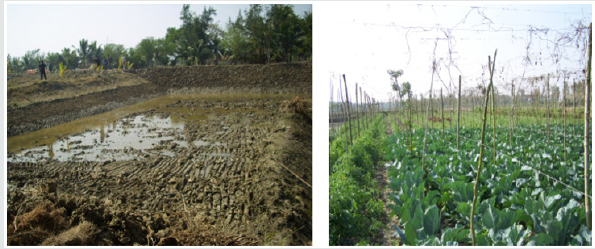

Results and Discussions
Financial Analysis and Partial Budgeting
Partial budgeting also known as marginal analysis is a
management tool that can compare the costs and returns that are
affected by a potential change in an intervention. It is especially
useful in evaluating budgets that involve small, specific, and
limited changes within an intervention by helping to determine the
profitability of that change. The partial budget can be divided into
three main sections: (I) costs, (II) benefits, and (III) analysis. The
analysis section includes net change in profits and a break-even
analysis also known as benefit/cost ratio. The possible changes
that can occur in an intervention fall into four categories. These
categories are added returns, reduced returns, added costs, and
reduced costs. The analysis section of the partial budget contains
both net change in profits and benefit/cost ratio analysis. In this
section as part of partial budgeting an attempt has been made to
present and discuss comparative figures of the socio-economic
status of farm households (adopted-30 & control 20) in terms of
basic production assets, Area under various activities, Employment
Generation, Cost of Cultivation (in Rs. / Acre), Income (Rs. / Acre)
and cost benefit ratio. Financial impact analysis based on primary
data collected from fields of intervention.
Cropping Pattern
It reveals from the survey data of households that there is a
distinct difference between the cropping pattern of adopted treated
households for the intervention land shaping aiming for improving
rainwater harvesting and drainage for enhancing productivity at
low lying degraded landat the District South 24 Parganas in the state
of West Bengal compared to those in the Control farmers selected
from the neighbouring areas. As a result of intervention in the form
of digging ponds for rainwater harvesting, availability of water for
irrigation for cropping on the pond dyke for vegetable cultivation
was available. Depending on the size of the pond irrigation was
available for the neighbouring plots also almost round the year
whereas in the control plots famers used to cultivate one seasonal
crop like conventional low yielding paddy. On the treated plots
good quantity of vegetables like tomato, bitter gourd, cucumber,
brinjal etc. were grown. This practice resulted in high production
from unit area accruing higher output. Therefore, it is attempted
to depict the input, output, components of cost of cultivation,
components of input cost, output in the form of table and graphs for
easy understanding of the differences between treated and control
farmers.
Yield Comparison between Treated and Control Plots
Yield of crop, vegetable and Fish are observed 1.66, 1.92 and
2.68 higher respectively in the intervened plots compared to those
produced in control (Figure 2).
Figure 2: Yield Comparison; Intervention: Land shaping for improvement of rainwater harvesting, District South 24 Parganas,
West Bengal.
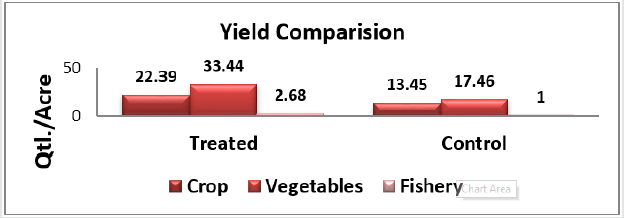

Employment Generation
It was one of the most important objectives to assess the
impact of the technology intervention on employment generation
compared to the control group and as such presented in Figure 3.
Employment generation was also higher for male, female and total
in the intervened plots to the extent of 1.7, 2.36 and 1.95 times
respectively compared to those generated in the control group.
Cost of Cultivation
An account of cost of cultivation being a very important factor
is being compiled and presented for both intervened and control
groups and displayed in table for comprehension of changes that
has occurred as a result of adoption technology compared to the
control groups (Table1).
Interpretation of Cost of Cultivation
Cost of cultivation was observed 1.9 times higher in treated
plots compared to that incurred in the control plots (Table1).
Component wise break up of cost of cultivation within treated plots
it is seen that on an average labour cost constituted 45% followed
by material input cost(29%),capital investment(13%) and farm
power (13%) whereas cost of cultivation for control plots were
on an average are found labour(47%),material input(25%),farm
power cost(15%),and capital cost(13%)(Figure 4). Further
partitioning of input cost for treated group exhibits that the highest
cost of cultivation was borne toward Fertiliser(46%) followed by
fish fingerling(17%),seed(12%) and the rest 12% jointly by seed
treatment, feed cost & pond maintenance but in case of Control
group the highest cost incurred was on account of Fertilise(55%)
followed by seed(18%)pesticide(17% and seed treatment(10%)
(Figure 5). It is interesting to note that in the intervened one NAIP
dug pond for rainwater harvesting that facilitated not only irrigation
for crops and vegetables but also fish culture also resulting in
higher return from unit area where as in the control plots farmers
cultivated single crop of paddy and some seasonal vegetables only
as can be evidenced from expenditure pattern and Input use.
Figure 4: Pie Chart showing Comparative Cost of Cultivation; Intervention: Land shaping for improvement of rainwater
harvesting, District South 24 Parganas, West Bengal.
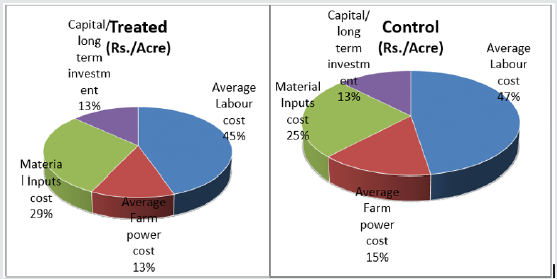

Figure 5: Pie Chart showing Comparative Cost of Material Input; Intervention: Land shaping for improvement of rainwater
harvesting, District South 24 Parganas, West Bengal.
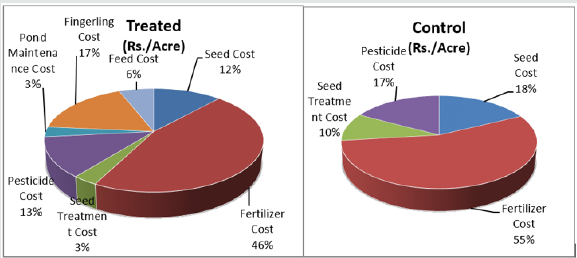

Income
A complete picture of Income (in Rs. / Acre) (Intervention: Land
Shaping technology): Treated VS Control is presented in Table 2.
Interpretation of Accrued Income
The ultimate interest is income for any enterprise. Therefore,
details of gross income, net income profit and cost benefit ratio
is presented side by side for comparison of treated and control
groups of farmers. Details of gross income, net income, profit and
cost benefit ratio is presented side by side for comparison of treated
and control groups of farmers (Table 2). It is clear from above table
that in case of Treated group average income was Rs.31, 262/
acre as against a negative income of Rs -8936/acre from Control
group. The same thing reflected in cost benefit ratio (Treated:1.37&
Control -0.42). It is well known that in theory, any project with a
B/C ratio exceeding 1 is worthwhile, most public agencies have
recognized that there is some uncertainty associated with both the
benefit and the cost estimates. Accordingly, it is not uncommon for
agencies to desire a threshold of B/C exceeding 1.5 for large new
projects, and 1.3 for incremental projects in which uncertainty is
less. The present case B/C ratio is at threshold level. Moreover;
Added returns and reduced costs fall into the benefits section of the
partial budget and are the positive effects of a proposed change in
the business as can be evidenced from the present analysis. Here
the net change between positive and negative economic effects is an
estimate of the net effect of making the proposed change in the total
farm budget. A positive net change indicates a potential increase in
income and a negative net change indicates a potential reduction in
income due to the proposed change (Figure 6).
Figure 6: Column Chart showing Comparison of Income; Intervention: Land shaping for improvement of rainwater harvesting,
District South 24 Parganas, West Bengal.
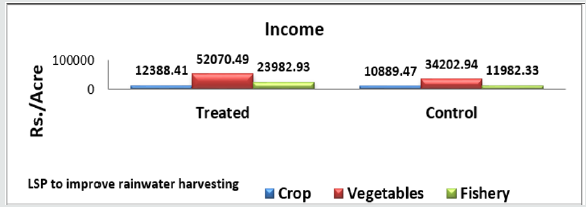

Variability in Financial Parameters
Descriptive statistics of various parameters are presented for
Treated Group (Table 3) and control group (Table 4). The coefficient
of variation of Total Cost of Cultivation, Total Income (Rs. /Acre) (Rs.
/Acre) and Profit from competing agro-enterprise (Rs. /Acre) are
observed to be 45.88, 36.20 and 79.27% respectively. and the same for
the control group are estimated to be 47.88, 23.79 and 100%
respectively. Surprisingly profit from competing agro-enterprise
showed 100% coefficient of variation. These high variations
indicate an alarming scenario of inconsistency in parametric values.
Table 3: Descriptive Statistics of some financial parameters of the Intervention: Land shaping (Adopted Farmers) to improve
rainwater harvesting – South 24 Parganas, West Bengal (Treated).

Conclusion
i) Relevance: Intervention of Land Shaping Technology by
NAIP is relevant as the activities and outputs of the programme
consistent with the intended impacts and effects as envisaged
in objective of the programme.
ii) Effectiveness: The Intervention is found to be effective
also as this intervention attained its objectives of rainwater
harvesting and utilisation saline and Tsunami affected land
for productive use to create employment and livelihood
opportunities of marginal farmers of Sundarbans region of
West Bengal State.
iii) Efficiency: Farmers adopting Land shaping technology
have got higher output compared to that achieved in control
group. From B/C ratio it is apparent that the technology is costefficient.
Therefore, in the present case of intervention is found
efficient.
iv) Sustainability: Sustainability is concerned with
measuring whether the benefits of an activity are likely to
continue after donor funding has been withdrawn. Projects
need to be environmentally as well as financially sustainable.
To what extent did the benefits of a programme or project
continue after donor funding ceased? Uniqueness of this
capital-intensive intervention /technology is that once the land
shaping in the form of pond is done it will remain so and can
be used for at least 5-10 years for productive purposes without
much maintenance. Interviewing cross section of adopted/
non-adopted/control farmers in the area, the IA consultant
got a clear idea that the farmers are going to continue with
the technology even after the funding is discontinued. It is also
observed that a lot of non-beneficiaries are also interested to
adopt the technology but unable to do so because of paucity of
fund of the poor and marginal farmers. Even it is reported that
the Govt. of West Bengal and Sundarbans Development Board
are investing substantial amount of resources to extend this
technology to the entire Sundarbans region.
v) Impact: Impact is known as the positive and negative
changes produced by a development intervention, directly
or indirectly, intended or unintended. This involves the main
impacts and effects resulting from the activity on the local
social, economic, environmental and other development
indicators. The impact of Land Shaping technology can be
assessed from the fact that the landscape and cropping pattern
has been changed from single crop to multi crop round the year
resulting in enhanced productivity, employment generation,
income and related activities arresting migration of people to
cities in search of jobs for livelihood. Livelihood opportunities
have increased considerably in the area without affecting the
environment. Beneficiaries and family members are fully
engaged in farming, marketing and associated activities. Many
people have been affected directly and indirectly in agriculture related
activities like farming, input supply, trading, marketing,
transport operations etc.
Follow on Linkedin : https://www.linkedin.com/company/lupinepublishers
Follow on Twitter : https://twitter.com/lupine_online
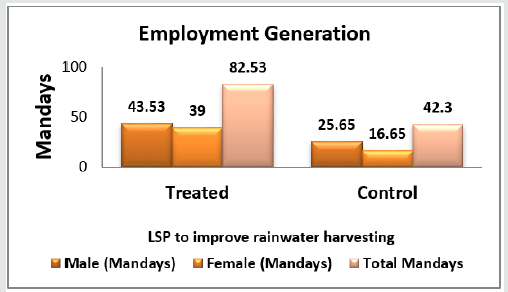
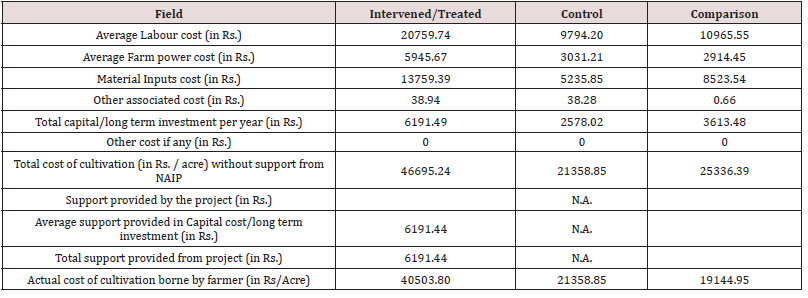
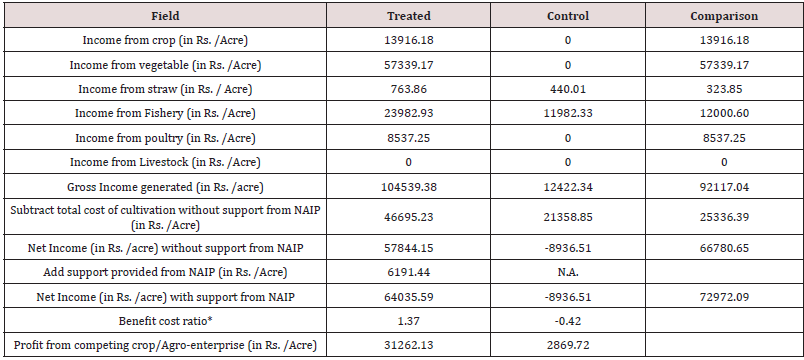

No comments:
Post a Comment
Note: only a member of this blog may post a comment.